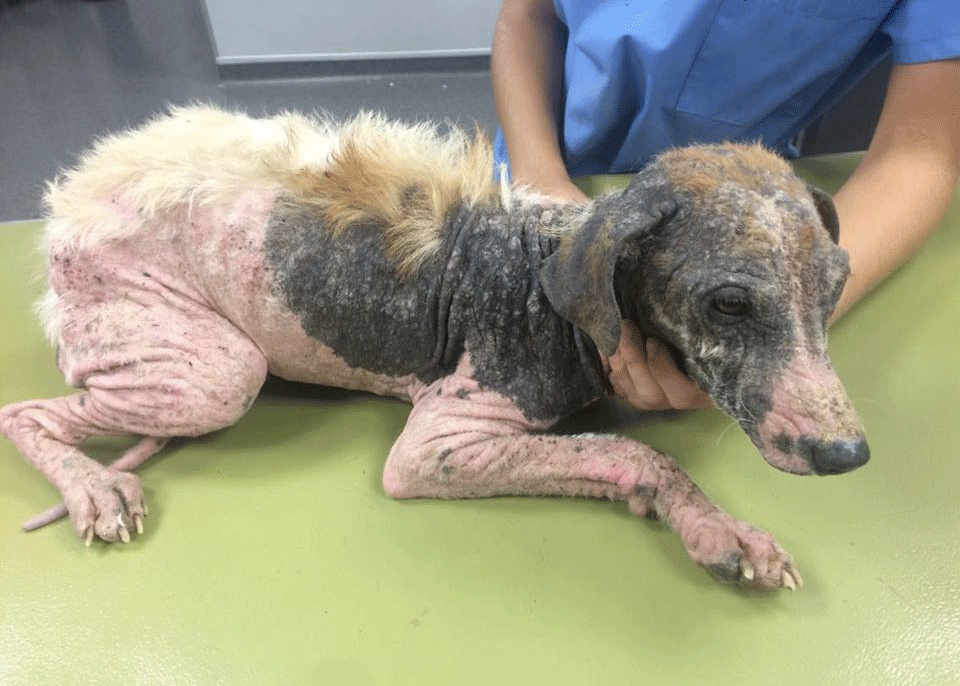Dog scabies
Scabies is a very common disease affecting the health of dogs, extremely contagious and capable of infecting an entire kennel in just a few weeks.
Fortunately, this disease can be easily cured, as long as the animal receives appropriate treatment. However, it is still necessary to know how to recognize it in order to treat it early, because it can be very painful for the dog, causing it to scratch itself to the point of bleeding in an attempt to calm the severe itching, which is symptomatic of this disease.
What is dog mange?
Dog scabies, also known as scabiosis or sarcoptic mange, is a parasitic disease caused by small mites that take up residence on your pet's skin to breed and lay their eggs. In this article, we will only talk about scabiosis, THE dog scabies, caused by the canine Sarcopte Sciabiei, a mite of which there are different varieties targeting different host species, including humans.
However, it should be noted that there are also other forms of mange: ear mange (or otacariosis) and demodeciasis (or demodecie), which are different from scabiosis, the latter being what is commonly called "dog mange". These three forms of mange do not have the same symptoms and are not caused by the same types of mites.
Otacariosis is caused by parasites that feed on the dead cells of the dog's ear canal, and demodecia is caused by the abnormal proliferation of mites that are naturally present on the animal's body (to clean it of its dead cells), a phenomenon that leads to generalized inflammation. Let's get back to our sarcoptic mange. It is a benign disease, but it does not heal on its own and must be treated by a veterinarian to allow the dog to recover completely.
It is very contagious and is quickly transmitted from one dog to another by simple contact. Most often, the "patient 0" has been infected by a fox, these wild carnivores being carriers of mange in more than 80% of cases. Sarcopte Sciabiei is an obligate parasite, which means that it can only survive by parasitizing a host, and dies within a few days, or even a few hours, when it is in an inert environment.
In fact, scabies is only transmitted from one dog to another, without any inert intermediary. Exceptions to this are in environments with a dense dog population (kennels, farms, etc.) where the parasite does not need to survive too long on an inert surface before coming across a new host. In rare cases, scabies can be complicated by more or less severe infections, due to intensive scratching, with dogs scratching or biting themselves to the point of bleeding in an attempt to stop the very virulent itching caused by these parasites.
Dogs with mange can develop a great deal of discomfort resulting in anorexia, insomnia, aggression and other disorders caused by the painful symptoms of the disease. It is also important to note that dog scabies is highly contagious and can be transmitted to humans, although the parasites are generally not able to reproduce on humans.
When a person is infected by his dog, it is usually sufficient to treat the animal for the parasites to disappear from his owner.

Causes of Dog Scabies
Once on your dog's back, the scabies mite, Sarcopte Sciabiei, begins its reproductive cycle, which lasts between 10 and 15 days. The parasites mate on the dog's dermis, then, after fertilization, the male dies and the female settles permanently on her host.
The female parasite will then dig a gallery in the most superficial layer of the dog's skin, advancing at a cruising speed of 1 to 2 mm per day, causing the intense itching typical of the disease. During its journey, the sarcoptes will feed on the cells of the dog's epidermis and lay between 3 to 5 eggs daily, all along its gallery.
The eggs hatch after a few days to give birth to a larva, which will emerge from the gallery to become a nymph, then an adult parasite in two weeks, before starting a new reproduction cycle.
Symptoms of dog mange
Dog scabies is essentially a very intense itching and pimples (papules). As the dog scratches, it presents new symptoms that are consecutive to the itching, and not directly to the parasites.
Most often, wounds are observed, possibly complicated by superinfection, scabs and hair loss, sometimes impressive. The areas of the body most affected are the chest, elbows, groin, ears, around the eyes, legs and flanks (in the end, only the back is usually spared).
When scabies is not treated quickly, the dog's general condition can deteriorate, with the itching causing such discomfort that the dog may lose sleep and appetite. Superinfections can also become widespread, especially in fragile, convalescent or immunocompromised animals, although fortunately this is a rather rare complication.

Treatment and prevention of scabies in dogs
Only a veterinarian is able to treat a dog with sarcoptic mange, after making a definitive diagnosis and determining the stage of the disease. Following his diagnosis, he can decide to implement a medical treatment through oral tablets, pipettes, shampoos or other lotions.
It is not necessarily useful to treat the dog's environment, since the parasites cannot survive anywhere other than on their preferred host. Dog mange mites may move to a cat or human once the dog has been treated, but they will not last long or become established.
The infected person or cat will potentially feel some itching, but will not usually develop any long-term symptoms, as the mites will die off on their own within a few days. With effective treatment, the parasite disappears completely after 15 to 30 days of treatment, but some lesions may take time to heal.
There is no treatment to prevent scabies in dogs, neither in the form of a pipette - as it is the case for fleas - nor in the form of a vaccine, since it is not a disease. The main thing is to avoid contact between your dog and visibly sick animals or wild foxes.
Hunting dogs that regularly come into contact with foxes should be closely monitored, so that they can be treated at the first sign of itching. Some blogs mention natural remedies or grandma's recipes to treat mange in dogs, based on white vinegar, aloe vera, bicarbonate or essential oils.
It is advisable not to try to treat your pet with these natural remedies, which have no proven effectiveness and can even be toxic for your dog (essential oils in particular). As scabies is an extremely painful disease for dogs, it is highly recommended to visit a veterinarian at the first signs of the disease to stop the terrible itching it causes.
FAQ
My dog has scabies, what should I do?
If your dog has scabies, or if you suspect he has scabies, the first thing to do is to go to a veterinarian who will make a definitive diagnosis. Scabies can be confused with a number of other skin conditions, including dog dermatitis, which is a common condition among our four-legged friends.
Can dog mange be transmitted to humans?
Yes, dog mange is highly contagious and can be transmitted to humans. However, the mites that cause this disease can only reproduce on dogs and therefore do not infect humans on a long-term basis.
Can my dog recover from scabies?
Yes, scabies is a very treatable disease with a very favorable prognosis. However, it should not be taken lightly and should be treated as soon as possible, because it causes unbearable itching.
How is scabies treated in dogs?
Dog scabies is treated with prescription medication after the veterinarian has made a definitive diagnosis and determined the course of the disease.
Can scabies in dogs be treated with natural remedies?
At this time, there are no grandmother's recipes or natural remedies that have been proven to be effective against scabies in dogs. It is highly recommended not to rely on urban legends and to take your pet to the veterinarian as soon as the first symptoms of the disease appear in order to avoid long days or weeks of suffering, which can lead to scratching until blood.
Dog scabies is a disease that plagues many animals around the world. Usually, however, dogs are infected accidentally, after having been in contact with a fox, or another dog that has come too close to it.

